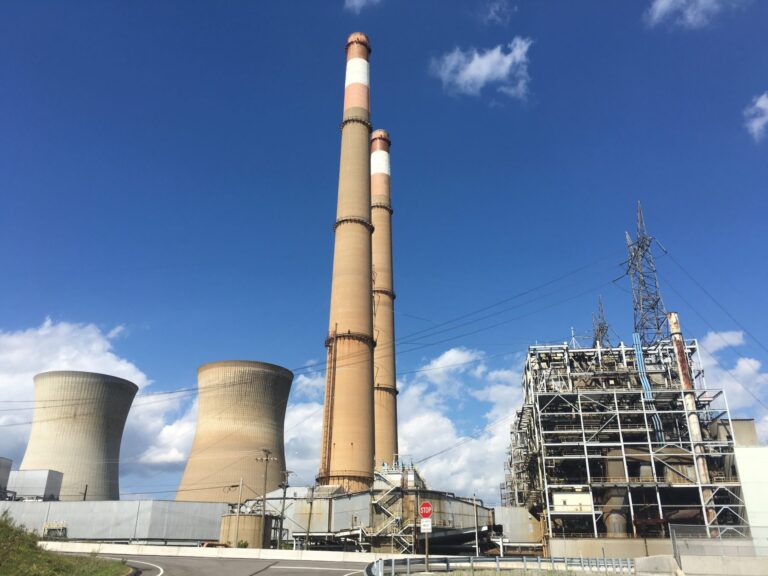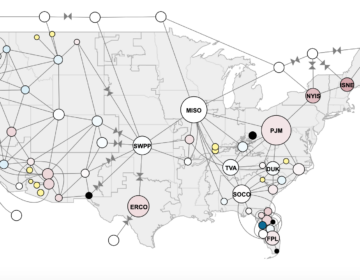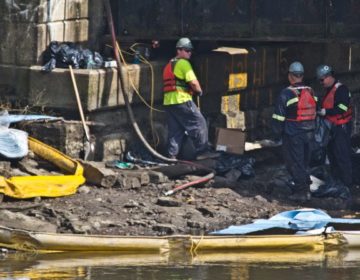How modern emissions compare to ancient, extinction-level events
Many of Earth’s most severe extinction crises have coincided with some of its largest volcanic events.

FirstEnergy’s Hatfield Ferry coal plant in Greene County closed in 2013 amid poor market conditions, helping Pennsylvania to meet its emissions targets under the federal Clean Power Plan. (Marie Cusick/StateImpact Pennsylvania)
This article originally appeared on StateImpact Pennsylvania.
–
Many of Earth’s most severe extinction crises have coincided with some of its largest volcanic events. At the end of the Triassic era (some 202 million years ago) the supercontinent Pangaea was breaking apart, the Atlantic Ocean was opening up, and millions of cubic kilometers of magma were bursting through Earth’s crust in a region known as the Central Atlantic Magmatic Province (CAMP). Pulses of volcanic activity, each lasting a few hundred to a few thousand years, released huge quantities of greenhouse gases from Earth’s internal plumbing system. The spike in carbon dioxide and other volcanic gases contributed to global warming and ocean acidification that wiped out more than three-quarters of species on Earth.
In a new study, an international team of researchers sought to quantify the amount of carbon dioxide released during the event. Their results, published today in Nature Communications, show that a single pulse of activity during the end-Triassic eruptions released as much carbon dioxide as humans are expected to emit over the course of the 21st century.
Researchers have known for some time that the formation of large igneous provinces is often followed by dramatic shifts in climate or mass extinctions. The Deccan Traps in India likely contributed to the demise of the dinosaurs, for example, and the Siberian Traps are believed to have triggered the end-Permian extinction, in which more than 90% of life on Earth was wiped out.
The CAMP is one of the most impressive large igneous provinces on Earth,” said Richard Ernst, a professor at both Canada’s Carleton University and Russia’s Tomsk State University who was not involved in the study. The total volume of the eruptive event would bury all of the United States, including Alaska, beneath a kilometer of basaltic magma, according to Ernst.
“These events are increasingly recognized to cause massive environmental change, and that’s being well documented by the precise dating that’s demonstrated that they’re associated in timing with the mass extinctions and other climatic change,” Ernst said. “The issue then turns more and more to what’s the mechanism?”
As a potent greenhouse gas, carbon dioxide is understood to drive these climate changes, he said. But what’s less clear is just how much carbon dioxide was released and where exactly it comes from: Is it largely derived from the mantle itself, or is it formed when hot magma hits the crust, cooking the organic materials found in sedimentary rocks? The answer has implications aboveground as well as belowground.
To find out, the team behind the new study looked at samples of basaltic lavas collected from the United States, Canada, Morocco, and Portugal, now distant landmasses that were separated by the emergence of the large igneous province known as CAMP.
But estimating carbon dioxide emissions for ancient eruptions is a challenge, according to Manfredo Capriolo, a Ph.D. student at the University of Padova in Italy and lead author on the new study. “Carbon is a volatile element,” he said. “It readily degasses during magma rise and eruption. Moreover, carbon may be added to old rocks due to alteration.”
The team had to distinguish between magmatic carbon in their samples and carbon that had been taken up as part of the natural weathering process of basalt deposits. To do so, they looked for melt inclusions in their samples—the blobs of melted rock and gases trapped within the crystals that form as magma cools.
“The crucial new data were those we obtained by Raman microspectroscopy analysis, which allowed us to detect micrometric carbon-bearing bubbles within melt inclusions, below the rock surface,” Capriolo said.
The team used carbon dioxide concentration in the bubbles to estimate the total abundance of carbon dioxide in the magma before it reached the surface to be 500 to 1,000 parts per million.
The high concentration of carbon dioxide in the magma helps to explain the pulsing eruption style that characterized the CAMP, according to the study authors. Carbon dioxide can accelerate the rise of magma through Earth’s layers. (Hawaii’s fountain-like eruptions, for example, are driven by its carbon dioxide–rich basalts.)
On the basis of the total volume of the CAMP, the carbon dioxide concentration of the magma, and the ratio of glass to gas bubbles within the melt inclusions, the team estimated the total amount of volcanic carbon dioxide released into the atmosphere.
They found that a single pulse of activity—the eruption of 100,000 cubic kilometers of magma over some 500 years—could have had a significant impact on the Triassic climate, much as our current emissions are drastically reshaping our world today. The entire CAMP event would have released roughly 100,000 gigatons of carbon dioxide—enough to warm the world by 10°C to 15°C. Put another way, Ernst said, “if we’re talking about going up 2° to 3° over a hundred years, we’re 20% of the way to a mass extinction.”
“There are countless variables that should be taken into account to foresee future climate change scenarios and that we are not able to constrain for the end-Triassic world,” Capriolo cautions. “However, as geoscientists, we warn that the currently ongoing carbon dioxide emissions are similar to those that led to the end-Triassic mass extinction.”
For Ernst, the new study underscores the importance of understanding Earth’s deep past in predicting how it will respond to future climate change. Climate scientists typically use sophisticated climate models based on decades of historical weather and climate data to predict future climate change. But, he said, “there’s a wealth of data from looking at Earth’s geology, Earth’s four and half billion year history of dramatic climate change, to provide insight into modern climate change.”
 This story originally appeared in Eos and is republished here as part of Covering Climate Now, a global journalism collaboration committed to strengthening coverage of the climate story.
This story originally appeared in Eos and is republished here as part of Covering Climate Now, a global journalism collaboration committed to strengthening coverage of the climate story.
WHYY is your source for fact-based, in-depth journalism and information. As a nonprofit organization, we rely on financial support from readers like you. Please give today.






